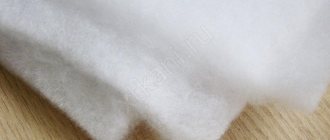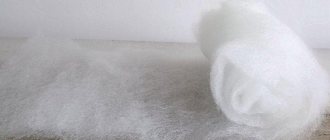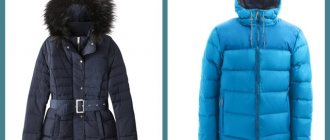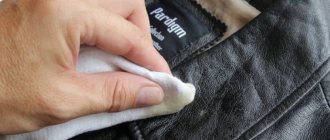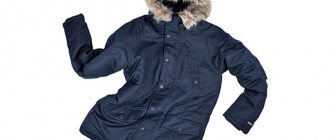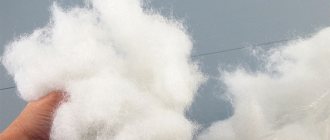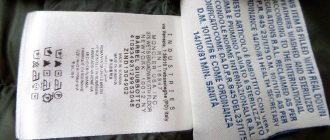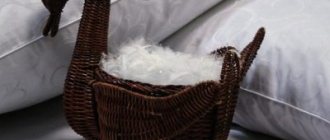Which down is better - goose, swan, duck?
a down jacket (or down jacket) has excellent heat-insulating properties. As we know from school, air is a very poor conductor of heat, which means the more air the jacket retains, the longer the heat coming from the body will remain under the clothes, and the cold winter air will not be able to get inside. Therefore, before you buy a down jacket, be sure to ask the seller what filler was used by the manufacturer in the manufacture of the down jacket you have chosen.
High-quality down jackets are those that contain goose, swan, duck or eider down. The latter has the best ability to retain heat, because Eiders are diving ducks that live in the Arctic. Thanks to their down, birds do not freeze even in the most severe frosts. However, due to the high difficulty of extracting such down, down jackets made from eiderdown are very expensive, and they are very difficult to find.
Characteristics of duck down
Down fillings are made from the down of waterfowl: eider, swan, goose, duck. Duck is one of the most common materials. Manufacturers turn to it often. But we have to figure out how good it is for down jacket owners.
Advantages
The rather small downy feather of a duck has a number of obvious advantages.
- Due to its naturalness, it is environmentally friendly.
- Duck down attracts with its lightness.
- The filler spreads well inside the clothes. The small size of the fluff allows you to evenly fill the inner space of the down jacket so that there are not even small areas left in the clothes free of fluff.
- A down jacket made from this material makes a person feel comfortable. After all, the filler retains heat well.
Reference. In such down jackets, even small children do not freeze during long walks at temperatures down to minus 25 ºC.
Flaws
Compared to other waterfowl, ducks cover their feathers with a fairly large layer of fat. It is secreted from the sebaceous glands of the bird and is necessary to protect its feathers when they come into contact with water.
Reference: the fatty layer of duck feathers is larger than similar protection in other birds: eider, swan, goose.
This feature leads to such negative features of the insulation.
Difficult and expensive cleaning
Because of this feature, before using it as a filler, it must be cleaned more thoroughly than other feathers. Strong detergents are used. They can not only wash away the sebaceous layer, but also get rid of the odor. But the complexity of the cleaning process increases the cost of insulation production.
There is one more disadvantage of such cleaning: the period during which the down plays an insulating role is reduced. This means that the lifespan of clothing becomes shorter.
Weight
The fat layer also affects the weight of the down, making it heavier. Therefore, jackets with such insulation are heavier than products with other contents.
Care
When washed in a machine, the contents of the jacket may clump. And after washing, it will take a long time for the product to dry completely.
Tip : If you need to wash a product with duck down filling, place a few tennis balls in the washing machine drum or in your clothing pockets. This will prevent lumps from forming.
Number of layers in a down jacket
Down jackets come in two-layer and single-layer varieties. If you are an outdoor enthusiast, skier, or just like to move a lot, you need a single-layer down jacket. Such jackets retain heat perfectly down to -10 .. -15 degrees. You won't overheat in them and they are more comfortable in size.
If you often have to be outside for a long time, you don’t move much and you have a harsh climate, you need double-layer down jackets. Be sure to check with the seller how many layers of fluff are in the product you choose. It is not always easy to do this yourself, therefore, in order to avoid becoming a victim of a counterfeit, it is better to buy down jackets in stores that inspire trust.
Waterproof down
To protect down from getting wet, it is treated with a hydrophobic (waterproof) coating at the molecular level.
If you love the warmth, lightness and superior movement that down insulation provides and you occasionally deal with wet weather, then waterproof down is your option.
Each manufacturer has its own names for such down, for example: Marmot Down Defender, DriDown, Q.Shield Down, DownTek, Hydrophobic Down and others.
Looking at the label of the down jacket
When purchasing a down jacket, carefully study its label. Here's what you can see on it:
- Down – this inscription means that the jacket uses down filling.
- Feather - feather. Keep in mind that it is almost impossible to find products made from 100% down, so if you are assured that a jacket is 100% down, and its price is below 20,000 rubles, they are most likely trying to deceive you.
- Products with the following inscriptions on the label: Polyester
(polyester),
Wool
(wool),
Cotton
(cotton) are not worth buying, unless of course you change your mind about buying a down jacket and decide to buy a padded jacket or a jacket with padding polyester.
In general, when purchasing any thing, you should always consider it in great detail. If threads are sticking out of the product, traces of glue are visible, the fittings are stuck, think about whether you should trust such sellers and the store as a whole.
Types of down used as filler
The duvet is particularly light and highly hygroscopic.
They retain heat perfectly. But the characteristics of ownership are affected by the ratio of down and feathers in the composition (in percentage). There are two types of fillers:
- Natural - these usually include bird feathers (ducks, gooses, eiders) and animal undercoat (camel and goat down).
- Artificial - this group includes synthetic swan down filler.
Natural
The cost of down bedding directly depends on the quality of the original filler. Raw materials are obtained from both poultry and live animals. The final price tag for the product depends on how the raw materials for the filler were obtained.
Most manufacturers use bird plumage to make duvets. Nowadays, most reputable enterprises give preference to collecting feathers from live birds. It can be collected during the natural molting period, so that the birds do not suffer.
The plumage of the following birds is used in production:
- ducks;
- goose;
- eiders
Products made from eider plumage are considered the most elite.
This species of bird lives in northern latitudes, in cold climates, so their feather material, like nothing else, can warm you even in frost. Products made from duck and goose down are considered simpler and more affordable. Feather material collected from a goose exceeds eider in weight. There are three goose down standards:
- Swiss (maximum volume indicators);
- European (high quality standard);
- world (has a relatively small volume and is used for the manufacture of cheap products).
There are also bedding stuffed with camel and goat down. Each type of raw material has its own advantages and disadvantages.
Advantages of products made from goat fur:
- relative lightness of blankets (natural filler gives blankets airiness and weightlessness);
- increased hygroscopicity (goat down absorbs moisture well, but does not change in weight, so the bedding will remain dry all the time, even in a particularly hot season);
- elasticity of products (the naturalness of the material helps it remain elastic, so blankets can restore their original volume even after prolonged use and not fall off over time).
But goat down also has its disadvantages:
- high thermal insulation (this can be both a plus and a minus, it all depends on what time of year you plan to purchase the product);
- demanding heat treatment and washing (incorrectly selected washing mode or incorrectly selected water temperature can ruin your blanket).
Last on the list, but not least important, is camel down. Many people confuse this material with camel hair, but these are two different fillers. Down is obtained by combing the light and soft undercoat of young camels. This material has a hollow texture, which helps maintain a fixed body temperature.
Camel down holds air, absorbs moisture (but quickly evaporates it), leaving your body dry. This filler does not electrify at all, is hypoallergenic, and relieves static voltage.
In addition, due to the high content of lanolin (animal wax), such blankets have a healing effect on your muscles and joints. Naturally, such products will be among the most expensive on the market.{banner_serefs}{banner_ondes}
Artificial
A separate category of blankets is filled with so-called “swan” down. This is a synthetic filler made from artificial microfiber. Such products do not absorb moisture, odors, and do not cause an allergic reaction, but may be too warm for off-season and summer use.
Blankets with artificial filling are often cheaper than natural ones, but they are much less permeable to air masses and can become electrified.
The benefits and harms of goose down
Each of us, when buying pillows, blankets, and even an item of clothing such as a jacket, is most often interested in what kind of filler is used in the middle of each product. In such a case, it is important that it is warm, environmentally friendly and safe for the human body. Nowadays there are a huge number of fillers, but the most popular and frequently used is goose down. Let's consider what properties and advantages this filler has and where it can be used.
How to care for a down jacket made of down and feathers
It is recommended to have the down jacket cleaned, but machine washing with liquid detergent on a delicate cycle is also allowed. To prevent fluff from forming clumps, three tennis balls are placed in the washing machine.
You should not wring out or dry the product in a machine; you should allow the water to drain by laying the down jacket on a horizontal mesh or grid. Then dry with a fan or hair dryer.
Bed dress
Pillows and blankets with such natural filling are very light, soft and warm. They keep their shape well and do not fall off. It is recommended to fluff your pillows by hand every morning (not in the evening).
Care
For such products, dry cleaning in specialized institutions is recommended. You can wash it yourself in a machine at a temperature of 40-60 degrees. Only high quality items are washed. In cheap ones, the filler is more fragile and can be damaged.
Do not dry in direct sunlight or on a radiator. It is best to do this in a well-ventilated area or outside in hot weather (only in the shade), shaking occasionally.
Useful
Down duvets and pillows are contraindicated for allergy sufferers and asthmatics, but many modern manufacturers carry out special anti-allergic treatment of raw materials.
Care for down and feather pillows in the video:
Raw materials
Gaga
The most valuable is considered to be the down of the northern eider bird, which lives in the Arctic climate of Iceland (eider down is also collected in Canada, Denmark, Finland and Norway). It is collected by hand directly from the nests. She plucks it out of herself to warm her offspring with the warmth of her skin.
All subsequent stages of processing are also carried out manually, since the fluffs have the highest degree of adhesion, and in the filled product they form a dense elastic layer that does not change shape during use. Products with eider down are incredibly light, airy and warm. This type of filler is the highest quality and most expensive.
Goose feather
Next comes goose down, which is also divided into categories. The most valuable is the white goose, followed by the gray goose. Its quality depends on both the breed of bird and the habitat: the harsher the climate in which the goose lives, the higher the quality. Canadian is considered the best. Next come the European breeds: Hungarian, Italian, North German and others.
The down of birds that live in harsh conditions, but fly to countries with warm climates (Turkey, China, Germany) for the winter, is of less quality.
Duck
Duck down and feathers are less valuable compared to goose feathers due to the shape of the feather - duck feathers are not curved like a goose's, but straight, therefore in finished products they lie denser and form fewer air spaces, therefore, such products are less warm and heavier .
In addition, duck plumage has a specific smell and requires additional processing. Canadian duck down is of very high quality.
On a note
White duck down is considered a universal insulation material. It is interesting that the raw materials for it are collected from nests, since this species of duck is listed in the Red Book. Birds prepare nests for their chicks by lining the bottom with down, which they pluck from the abdomen and chest. They cover the laid eggs with the same down.
Chicken feather as a filler
It only has a feather. Used for the production of goods in the lowest price segment.
Read about: canvas-stitched fabric: practicality and functionality of non-woven material
Down structure and properties
The question of what fluff is is probably best answered by specialist ornithologists. They will say that this is a special type of feather, which in adult birds is located under the so-called contour feathers, and in chicks it is the only type of plumage. Scientists will use terms like “fan”, “fan” and “beards”, but this is not the secret of the warming ability of down. The effectiveness of down insulation lies in the structure of the fluff and its ability to hold air in the tangles of tiny fibers.
The fluffs have almost no hard elements, they are small in size and can adhere to each other. Thanks to this, down is a light, air-filled spatial structure that quickly restores its original volume after compression. The low thermal conductivity of down, combined with minimal weight, makes its characteristics practically unattainable for modern artificial insulation, which is not surprising, since evolution has been improving down for many thousands of years. In many ways, it is down that allows waterfowl of northern latitudes to live and reproduce in such climatic conditions in which any of us would freeze in a matter of minutes without additional heating.
Man, who is inferior to evolution in terms of engineering talent, is still, for the most part, more cunning than northern birds, not to mention the geese of the middle zone. It was for this reason that he began to obtain down by plucking geese, to which the geese can respond to him only occasionally by pinching the legs of the shepherdesses, beautiful in soul and body.
In addition to uniquely effective heat conservation, down also has high hygroscopicity (or hydrophilicity) - the ability to absorb water vapor from the air. When using down clothing, this property of down helps to get rid of excess moisture resulting from evaporation from the surface of the skin. True, hygroscopicity can also lead to a negative effect - sorption, that is, moistening of down, which reduces its heat-saving characteristics. Weakening this effect is a task for clothing designers - let them work on the details, if in the main they are not competitors by nature.
The exceptional properties of down are fully manifested only if all necessary technological requirements and standards are observed during its extraction and processing. The quality and characteristics of down are assessed by various laboratories that conduct tests on samples of down products.
Among such tests are microbiological, isotopic (to determine the geographical origin of fluff), tests for the presence of foreign impurities, and a test to determine the elasticity index Fill Power. Detailed information about ways to evaluate the quality of down is contained in the article “How down becomes insulation.”
The only thing worse than chicken fluff is fish fur.
The right choice when purchasing
When choosing a product with down, you need to approach it wisely. An important point is the speed of returning to its original shape. Ideally, it is fully restored in 2-3 minutes.
Blankets and pillows
You need to choose a pillow according to several criteria. Products with eider down are rare and extremely expensive. Swan filler is an artificial material, and the name is just a marketing ploy. Goose down is optimal in terms of price and quality.
An important indicator is the ratio of down and feathers. The more of the latter, the lower the category.
The density of the packing is important. If it is low, then the pillow is the softest. It is better to match it to a firm mattress. Thick padding is recommended for people with a large build; it goes better with a soft mattress. Medium density is universal.
When choosing a down pillow, the material of the cover and the quality of the seams are important. Filling will not come out of thick fabric.
When purchasing a down blanket, it is recommended to choose cassette quilting (in squares). In this case, the filler is distributed more evenly and does not come out. You need a cover made of fairly thick silk or cotton fabric. If the composition contains no more than 15% feather, then its sharp tips should not be felt.
Outerwear
When choosing a down jacket with natural filling, the density of the latter and the volume of the feather are important. The higher the Fill power level and the more pure down, the warmer the jacket. Ideal proportions are considered to be when the feather content is up to 20%. If there is a lot of it, the quality is lower, the thing heats worse. The feather can pierce the fabric with its tips - this is unsightly and unpleasant.
An important factor is the quilting of the down jacket. The larger the sections, the higher the risk of filler clumping. The quality of the seams is also important. You need to check if the filler is leaking out of them.
Duck down in a down jacket: warm or not
Down jackets are the most popular clothing for the cold season. Despite their lightness, they perfectly warm, protect from the wind, and are indispensable during winter rain or snowfall. The advantages of down jackets largely depend on their filling. (holofiber, Thinsulate, Isosoft, synthetic down, etc.) are used for insulation in clothing Another option is to use natural materials (wool, down, which is often supplemented with feathers). When choosing a product, you need to take into account the properties and qualities of various insulation materials. We will tell you what duck down insulation is, whether it is warm, and how many degrees it retains heat.
